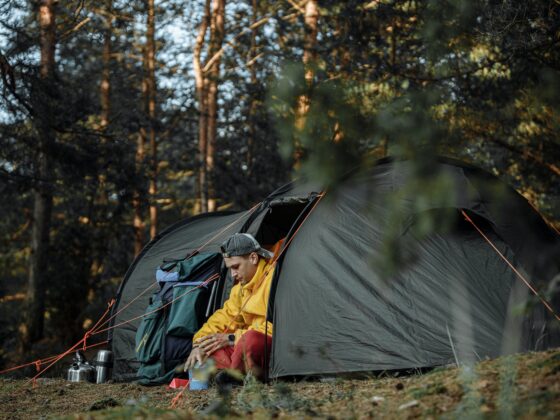Are you an outdoor enthusiast who loves camping under the stars? If so, ensuring the longevity of your camping tent should be at the top of your priority list. In this article, we will provide you with expert tips on outdoor tent repair and maintenance to keep your gear in top shape for countless camping adventures.
Caring for your tent is essential to maximize its lifespan and prevent unexpected mishaps while out in the wilderness. From patching up holes and tears to protecting against UV damage and mildew, we’ve got you covered. That said, Our this article has compiled a comprehensive guide to help you navigate the world of tent repair and maintenance.
Importance of Tent Repair and Maintenance
Proper tent repair and maintenance can make a world of difference in the longevity and performance of your gear. That said, shopping for a high-quality camping tent is paramount. When you invest in a high-quality tent, you want it to last for many years and withstand various weather conditions. Regular maintenance and timely repairs can help you achieve that.
One of the main benefits of tent repair and maintenance is preventing small issues from turning into big problems. By addressing minor tears or leaks promptly, you can avoid costly repairs or having to replace your tent altogether (and save yourself another trip to the outdoor store). Additionally, well-maintained tents are less likely to fail you in the middle of a camping trip, ensuring a comfortable and safe experience.
Common Tent Problems and How to Identify Them
Before diving into the repair and maintenance process, it’s important to know the common problems that tents often encounter. By familiarizing yourself with these issues, you can quickly identify any potential damage and take the necessary steps to fix it.
One of the most common problems is a torn or punctured tent fabric. This can occur due to sharp objects, rough handling, or wear and tear over time. Look for any visible holes or tears in the fabric, paying close attention to the seams and high-stress areas. Additionally, check for any broken tent pegs, poles, bent stakes, or damaged zippers, as these can also impact the functionality of your tent.
Essential Tools for Tent Repair and Maintenance
To effectively repair and maintain your tent, you’ll need a few essential tools and supplies. These items will help you address various issues and ensure a successful repair process. Here are some must-have tools for tent repair and maintenance:
- Tent repair tape – This specialized tape is designed to patch up small holes and tears in tent fabric. It is durable, waterproof, and easy to apply, making it an essential item for quick repairs.
- Seam sealer – Seam sealer is used to seal the seams of your tent, preventing water from seeping through. It is particularly important for waterproofing and ensuring the longevity of your tent.
- Tent pole repair sleeve – If your tent poles are damaged or broken, a repair sleeve can be used to fix them temporarily. It provides stability and support until you can replace the poles.
- Tent stake mallet – A sturdy mallet is essential for driving tent stakes into the ground. It ensures a secure and stable setup, preventing your tent from collapsing in windy conditions.
- Fabric cleaner – To keep your tent clean and free from mildew, it’s important to have a fabric cleaner specifically designed for outdoor gear. This will help remove dirt, stains, and odors without damaging the fabric.
Patching and Sealing Tent Seams
Seams are one of the most vulnerable areas of a tent when it comes to leaks. Over time, the seam tape may wear off or become damaged, compromising the waterproofing of your tent. Patching and sealing tent seams is a crucial step in maintaining the integrity of your shelter.
To patch a torn or damaged seam, start by cleaning the area around the seam with a mild detergent and water. Allow it to dry completely before applying a thin layer of seam sealer. Gently press the seam sealer into the damaged area, ensuring full coverage. Let it dry according to the manufacturer’s instructions.
In addition to patching, it’s important to regularly inspect the seams of your tent for any signs of wear or damage. If the seam tape is peeling off or showing signs of deterioration, it’s time to reapply the seam sealer. This will help maintain the waterproofing capabilities of your tent and prevent leaks during rainy weather.
Repairing Tent Poles and Stakes
Tent poles and stakes are vital components of your tent’s structure. If they are damaged or broken, it can significantly impact the stability and functionality of your shelter. To ensure a successful repair, follow these steps:
- Assess the damage: Carefully inspect your tent poles and stakes for any visible signs of damage. Look for cracks, bends, or splintered sections. If there are any broken parts, determine whether they can be repaired or need to be replaced.
- Temporary fixes: If a tent pole is bent but not broken, you can often straighten it using gentle force. However, if it’s severely damaged or broken, a tent pole repair sleeve can be used as a temporary fix until you can obtain a replacement pole.
- Replacing tent poles: If your tent poles are beyond repair, it’s essential to replace them with the correct size and type. Many tent manufacturers offer replacement parts, so check with them first. Alternatively, you can find universal tent poles that fit various brands and models.
- Fixing tent stakes: Bent or damaged tent stakes can be straightened using a pair of pliers. However, if they are broken, it’s best to replace them altogether. Invest in high-quality tent stakes that are durable and designed to withstand various ground conditions.
Cleaning and Waterproofing Your Tent
Regular cleaning and waterproofing are essential for maintaining the performance and longevity of your tent. Over time, dirt, grime, and body oils can accumulate on the fabric, compromising its waterproof capabilities. Here’s a step-by-step guide on how to clean and waterproof your tent:
- Spot cleaning: Start by spot cleaning any visible stains or dirt using a sponge or soft brush with mild detergent and warm water. Gently scrub the affected areas, then rinse thoroughly. Avoid using harsh chemicals or abrasive materials, as they can damage the fabric.
- Full tent cleaning: For more thorough cleaning, set up your tent outside and hose it down with water. Use a gentle spray to remove dirt and debris from the fabric. If necessary, you can use a non-detergent soap or a specialized fabric cleaner. Rinse the tent thoroughly to remove any soap residue.
- Drying: After cleaning, allow your tent to air dry completely. Avoid direct sunlight, as it can cause UV damage to the fabric. Make sure the tent is completely dry before storing it to prevent mold and mildew growth.
- Waterproofing: Once your tent is clean and dry, it’s time to apply a waterproofing treatment. There are various spray-on waterproofing products available on the market. Follow the manufacturer’s instructions for application, ensuring full coverage. Pay extra attention to the seams and high-stress areas.
Storing Your Tent Properly
Proper storage is essential for preserving the lifespan of your tent. Improper storage can lead to mold and mildew growth, fabric deterioration, and damage to the poles. Follow these tips to ensure your tent stays in top condition:
- Clean and dry: Before storing your tent, make sure it is clean and completely dry. Any moisture left in the fabric can lead to mold and mildew growth, causing irreversible damage.
- Loose storage: Avoid tightly compressing your tent when storing it. This can cause creases in the fabric and put unnecessary stress on the poles. Instead, loosely fold or roll the tent to prevent permanent creasing.
- Breathable storage bag: Use a breathable storage bag or sack to store your tent. Avoid using plastic bags, as they can trap moisture and promote mold growth. A mesh or fabric bag allows for proper ventilation, keeping your tent fresh and dry.
- Cool and dry location: Store your tent in a cool and dry location, away from direct sunlight and extreme temperatures. A basement, closet, or temperature-controlled storage area is ideal. Avoid storing your tent in an attic or garage, as these areas are prone to temperature fluctuations and moisture buildup.
Tips for Prolonging the Lifespan of Your Tent
In addition to regular maintenance and repairs, there are several tips you can follow to prolong the lifespan of your tent:
- Choose a suitable campsite: When setting up your tent, choose a campsite that is free from sharp rocks, branches, or other potential hazards that could damage the fabric or poles.
- Use a groundsheet: A groundsheet or footprint can provide an extra layer of protection for the floor of your tent. It helps prevent tears, abrasions, and moisture from seeping through.
- Avoid storing wet: If you need to pack up your tent while it’s still wet, make sure to set it up and dry it as soon as possible. Storing a wet tent for an extended period can lead to mold and mildew growth.
- Ventilate your tent: Proper airflow is important to prevent condensation and reduce the risk of mold and mildew. Keep the vents open and use a rainfly when necessary to promote ventilation.
- Avoid long-term sun exposure: Prolonged exposure to direct sunlight can weaken the fabric and cause UV damage. Whenever possible, set up your tent in shaded areas or use a sunshade to protect it from harmful UV rays.
Professional Tent Repair Services
While many tent repairs can be done at home, there are instances when professional help may be necessary. If your tent requires extensive repairs or if you’re unsure about handling a specific issue, it’s best to seek the assistance of a professional tent repair service. These experts have the knowledge and experience to tackle complex repairs and ensure your tent is in optimal condition.
Conclusion
Don’t let a damaged tent dampen your camping experience. By following the tips and techniques outlined in this article, you can effectively repair and maintain your tent, ensuring it remains a reliable shelter for years to come. From patching up holes and tears to cleaning and waterproofing, taking care of your tent is an investment worth making. So, gear up and get ready to embark on countless camping adventures with a well-maintained and reliable tent.



